All about veneering plywood
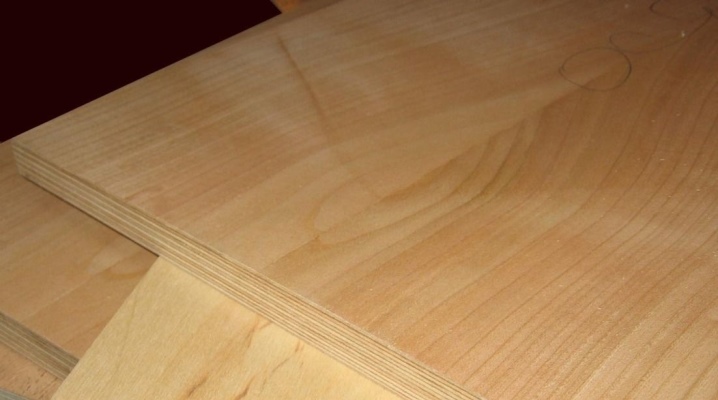
Making furniture or a door leaf from solid wood material in modern conditions is a difficult and very expensive task. Therefore, for mass production, glued sawn timber in the form of plywood, consisting of several layers of natural wood, is used. As a rule, cheap wood species are used to give the material a presentable look, it is veneered. Veneer should be understood as the thinnest cut of valuable wood, which is glued to the surface of an inexpensive material. The price of veneered materials is quite affordable, and their appearance is distinguished by aesthetics and beauty.
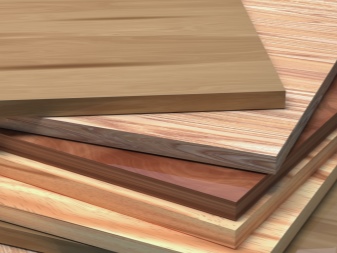
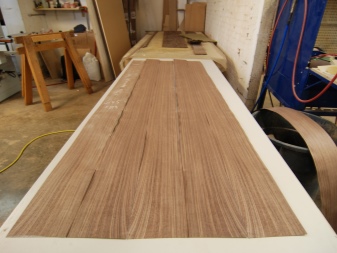
Peculiarities
Products made from plywood with veneer finish look like they are made from natural wood.
In addition to a noble and naturalistic look, veneered material also has a lot of advantages that manifest themselves during the operation of the product.

Depending on the manufacturing technology, the veneer material is divided into several types.
- Peeled - it is obtained by cutting off a thin layer of wood at the moment when thin sheets of material are cut from a log clamped on a special machine. The veneer is cut strictly in the direction of its grain. Alder, pine, oak or birch are subjected to similar processing. This type of veneer is used for facing and furniture materials.

- Sawn - this type of veneer is obtained on a machine that is equipped with saw blades, their number is up to 20 units. After passing through such canvases, the log is sawn into thin and even workpieces. Sawed veneer has a high degree of wear resistance. This type of processing is used for soft conifers. Finished lumber is used for the production of musical instruments, parquet boards, expensive designer furniture.
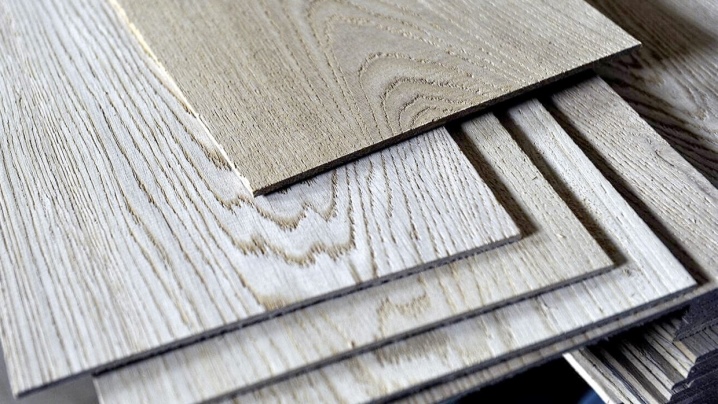
- Planed - is made from hard and valuable wood species. Mahogany, oak, beech are processed. The process of cutting layers is carried out on the machine. The layers are carefully cut with special knives perpendicular to the course of the fibers. As a result of this processing, a high quality and thin wood veneer is obtained. It is used to make expensive door leaves and exclusive furniture.
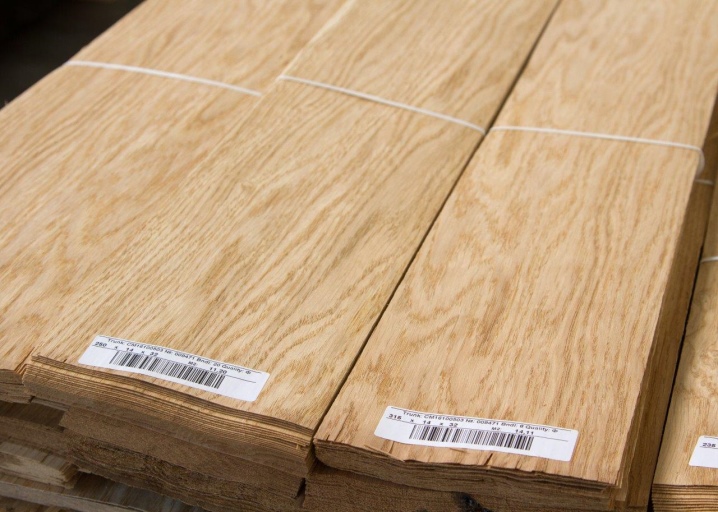
In the production where plywood veneering is performed, sliced veneer is most often used. Before starting the cladding, the wood material is cleaned and polished with high quality. After that, the veneer must be cut according to the parameters of the veneered surface.
Then, an adhesive composition is distributed on this surface, which consists of a base and a polymerization hardener. Once the glue is evenly applied, cover the work surface with a thin layer of veneer.

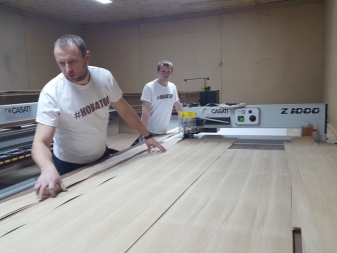
For its strong adhesion, the workpiece is sent under a press, where, under the influence of high temperatures, the surface of the product is leveled, and the veneer is firmly connected to the plywood. Excess adhesive that may form on the edges of the workpiece is removed by grinding. When the veneering process is completed, the product is treated with varnish - matte or glossy. The varnish will protect the product from mechanical stress and dirt.
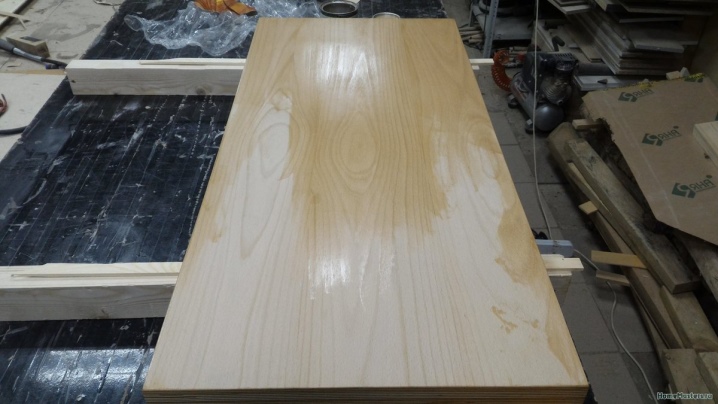
Veneered material has a number of advantages over conventional plywood:
- attractive appearance;
- resistance to environmental influences;
- a large selection of colors and textures of wood;
- the ability to combine various textures and colors of materials in one product;
- low cost of products in comparison with solid wood.
But no matter how high quality veneered plywood is, it requires careful handling.
In terms of its resistance to mechanical stress, it is, of course, inferior to solid wood.



Choice of materials
In the production of veneered materials, the types of products are subdivided depending on the raw materials used, natural species of wood.
Ash veneered material
The structure of this wood has light colors and a subtle natural pattern. Ash veneer is good because it has elasticity and rarely splits... Ash veneer thickness ranges from 0.5 to 0.6 mm. Ash is resistant to sudden changes in temperature conditions and does not react to this by splitting.
Ash veneered lumber is used for the manufacture of door panels, parquet, in furniture production (cabinet furniture facades and much more). Ash veneered plywood is often used for indoor wall cladding.


Material veneered with oak
It has a bright and rich tone, as well as a strongly pronounced woody pattern. The veneer texture has high reliability and long-term operational capabilities... The thickness of oak veneer can be from 0.3 to 0.6 mm. Materials that are veneered with oak veneer are not as flexible, but very durable.
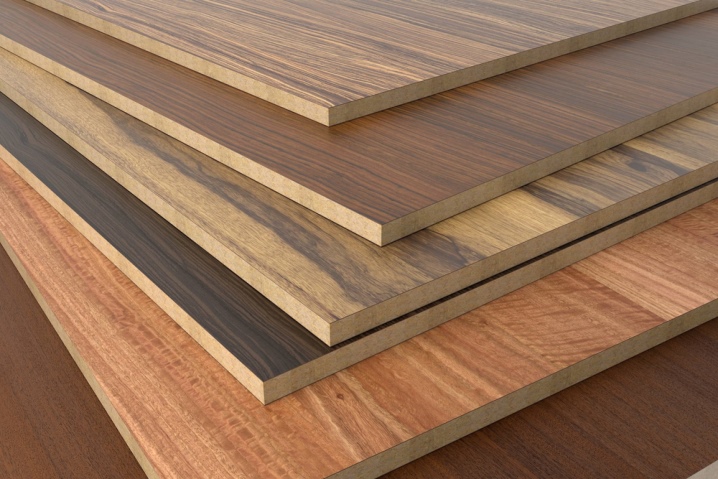
Oak veneer is used for the production of decorative wall panels, as well as for the implementation of large-sized elements of furniture decor.
In addition to high-quality veneer, plywood veneering requires adhesive composition. Its characteristics depend on the thickness of the facing lumber and its properties. In order to carry out the veneering process with your own hands, you can use wood glue or PVA composition. It is worth noting that these types of adhesives are only suitable if the work surface of the product is well sanded. For complex parts with protrusions and fanciful shapes, you will need a glue of a stronger composition and a high degree of adhesion. For this purpose, polyurethane compositions are used, for example, glue Kleiberit or Titebond.
After the front part of the workpiece is pasted over with veneer, it is necessary to glue the material along its edges. This crucial step is performed with even more durable types of adhesives. For example, an epoxy resin or an adhesive containing it can be used as such a means.


Bonding methods
The quality of the veneered material and its strength directly depend on the how neatly and accurately the veneer was glued to the plywood blank... There are 3 types of veneer fixing methods.
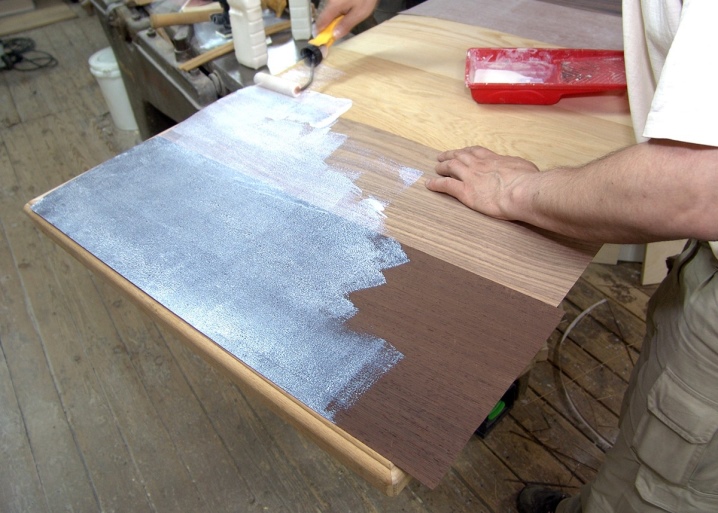
Cold contact method
This is considered to be the most difficult way to perform veneer gluing. For its implementation, an adhesive composition is used, which is able to quickly polymerize. This solidification rate has its pros and cons. The fact is that due to the fast adhesion, defects in the location of the veneer on the workpiece may not be noticed and corrected in time, and after polymerization it is no longer possible to change anything.
If the veneer lay flat and tightly on the workpiece, then to strengthen the adhesion of the two surfaces, it is necessary to create a clamp with reinforcement.
For this purpose, the workpiece is placed under a special pressing press, or press it manually. In this way, it is recommended to process workpieces that are small in size.


Hot glue method
The essence of this method is that the surface of the workpiece and the surface of the veneer are separately processed with glue. The adhesive composition should dry out a little, after which the veneer is applied to the workpiece. Next, the veneered surface is treated with a hot press or iron, if the work is done at home. In order not to spoil the finish, iron the veneer through a layer of clean paper.At this time, under the influence of high temperature, the adhesive composition will melt and create high adhesion.
To perform this finishing method, a thick adhesive composition is used.... In the event of air bubbles or unevenness during the gluing of materials, the situation can be corrected. The adhesive composition, which in the form of surplus has left the workpiece, is removed with a damp cloth.

Cold jointing method with pressing
The method is based on the use of squeezing devices called clamps. Compression of the bonded surfaces is carried out until the glue is completely polymerized.
Choosing one or another type of veneering, it is important to complete the subsequent stages of work. After the glue dries, I grind the workpiece a little and cover it with a transparent quick-drying varnish. Already 24 hours after veneering, the product can be used.
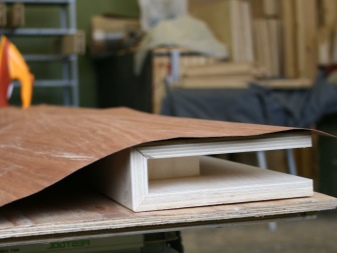

How to veneer?
You can glue the veneer on plywood at home with your own hands.
Such work is performed when they want to restore used furniture or a door leaf.
The sticker of the finishing lumber is carried out after completing a certain cycle of preparatory work.
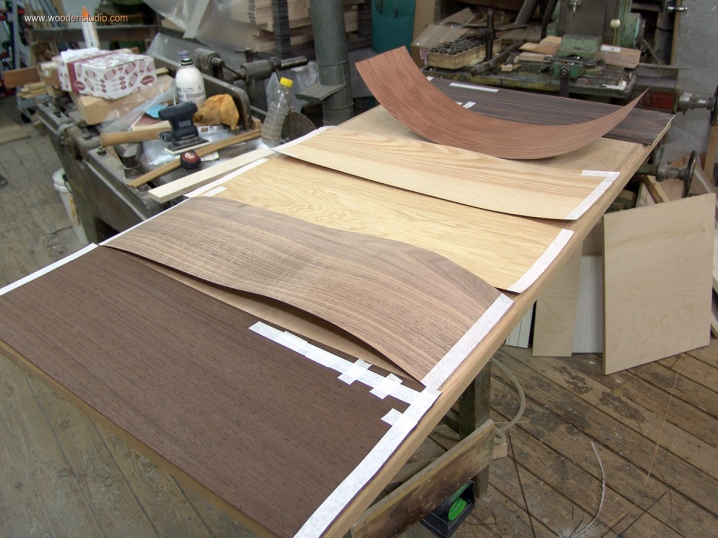
Preparation
Furniture facades or interior doors must be dismantled, all decorative elements and metal fittings removed from them. Before you start gluing the veneer, you need to prepare your workplace. It is most convenient to do this on a carpentry table, or install old chairs as an impromptu platform.
When the workpiece is freed from all the elements, they begin to clean it up. It is necessary to remove the old varnish coat. It is removed with a thin metal spatula, and you can also use the hot air jet of a construction hair dryer. If the workpiece is new and made of soft coniferous trees, irregularities in the form of knots or drops of protruding resin must be cleaned.
The area where the resin was, for degreasing, then wipe with acetone or solvent.
The next stage of work will be the performance of high-quality surface grinding. If there are potholes or cracks, they are putty with a compound containing the components of wood glue. After sanding, the surface must be primed before applying the adhesive.

Cut open
In the retail network, veneer can be purchased in the form of sheets rolled into rolls. Before cutting them, the lumber must be straightened. To do this, the roll is rolled out on the floor and moistened with a cloth moistened with water. Next, a sheet of plywood or drywall is applied over the lumber, pressing them on top with some heavy object. It will take time for the veneer sheets to align - only then can they be cut. This procedure is done as follows:
- the surface of the workpiece is measured;
- the dimensions obtained are marked on a veneer sheet, while on each side an additional 5 cm is put aside in the stock in case of an incorrect measurement;
- according to the intended dimensions, a part is cut out of veneer with a special plywood knife or an immersion-type saw (scissors are used only as a last resort, since their use can lead to cracking of the canvas).

Sometimes it is necessary to join several veneer sheets together. This can be done with gummed tape, laying it on the back of the lumber.
To make the wood grain pattern look as natural as possible, it is carefully selected... The connected canvas is made with allowances from a given size by 5-7 cm.
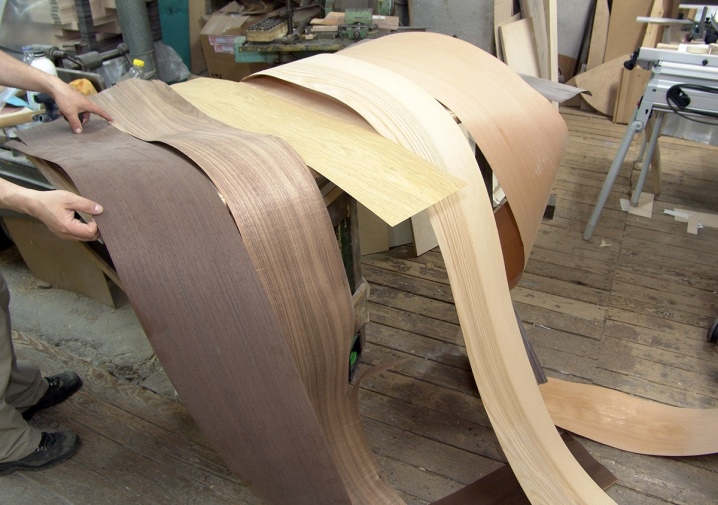
Veneering
At this stage it is important to evenly glue the workpiece in the chosen way. Prepare glue, brush, cloth, clean paper and iron for work. The veneer is turned upside down and fixed at the corners with clamps, after which the adhesive is applied. And also the prepared workpiece is processed with glue. Next, the veneer is glued to the workpiece, avoiding distortion of the material and bubbles.After gluing and eliminating small errors, paper is applied to the surface of the part and passes through the material from the center to the edges with an iron, pressing it with force. After the front part is finished, the excess material is trimmed with a sharp knife. Then, the end parts of the workpiece are lined with narrower veneer strips.
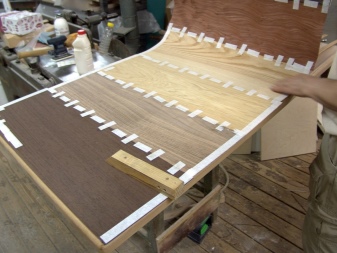
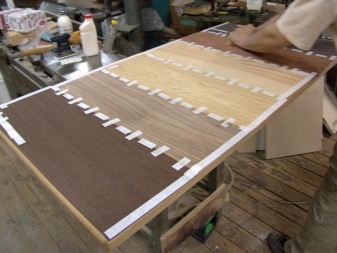
Any protruding glue and excess material must be removed immediately.
When the glue is completely dry, the edges of the cladding are cleaned with fine emery paper or with a file, depending on the thickness of the material. After finishing the work, the product must be covered with nitro varnish.
How to veneer plywood at home, see below.













The comment was sent successfully.